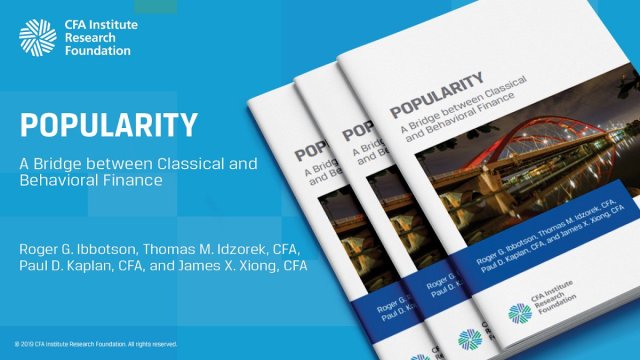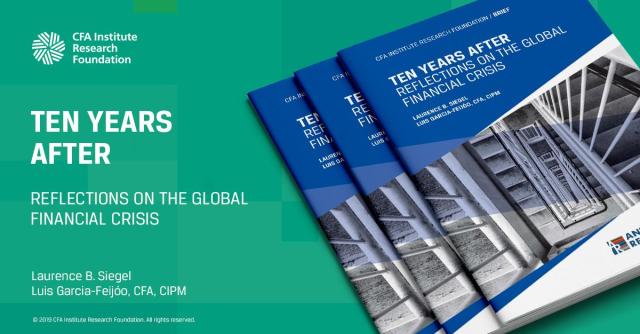[ad_1]
Roger G. Ibbotson is among the best-known scholars and practitioners in the field of asset allocation. I had the privilege of working with him at Ibbotson Associates. I spoke with him on the subject a while back and thought the present was a good time to share some of his insights.
What follows is a lightly edited transcript of our discussion.
Larry Cao, CFA: Many in the industry still ask, how important is asset allocation? Can you walk us through that? What percentage of performance is explained by asset allocation?
Roger G. Ibbotson: Back in the old days, people considered you an investment genius if the market was up. Essentially money managers took credit [or blame] for whatever movements were in the market. After the capital asset pricing model, they wanted to adjust for the beta of the market.
So how important is beta, or asset allocation? I wrote a paper in 2000 with Paul Kaplan called “Does Asset Allocation Explain Allocation Policy Explain 40, 90, or 100 Percent of Performance?”
I’ll start with the 90% because it was made famous in the various studies by Gary Brinson. It really is an R square of measuring the return of a portfolio compared to its policy. The policy is the independent variable and the typical R square is about 90%. It’s essentially looking at the time series, across time, about 90% of the variance is explained by the asset allocation policy.
I thought it was far more meaningful to look at it across money managers to see how our money managers differ from each other. It turns out that part of the difference is from the different policies and part of the difference is active management. The answer in that study for the former was 40%. Later when I studied that with James Xiong, it was decided that both were equally important.
Can
you tell our readers more about what the 100% number means?
Many people talk about how 90% of the return comes from asset allocation. That’s not true. Really the answer to that question is 100% of the return, or more than 100% of the return, comes from the policy because the actual return tends to be less than the policy in the average case. So if you were measuring the level of return, which people think is what’s being measured (in the Brinson studies), the answer is about 100%.
Will
the 40% or 50% number go up as researchers identify more factors?
There are a couple of recent studies, one by Green, Hand, and Zhang and another by Campbell Harvey, et al. The papers identified about 100 and 300 factors, respectively. The more detailed your policy is, the higher the percent that you are going to explain by your policy.
Of course, the more passive your strategies are, the higher percent of your particular portfolio can be related to your policy. And if you ignore your policy, you are going to have almost 0% on your policy. So it depends on the nature of your actual portfolio management. This 50% was just sort of an empirical average when you look at mutual funds. The 40% was looking at pension funds.
I think one reason that people have been arguing for risk factor allocation is because the three-factor or five-factor models are simpler and easier to follow compared to the asset class model where you might have many more asset classes. But if we were thinking about 100 factors or 300 factors, does that simplify anything anymore?
I have some qualms about factor models,
because factor models are typically looking at the sensitivity of an asset
class to some underlying factor. It is somewhat difficult to actually carry
this out specifically, because first of all, your factor sensitivity is always
something that is being estimated and it is going to have a lot of estimation
error associated with it.
And I want to get into this food analogy
that is often made on factors. So, they say, you should look at food from a
nutrient perspective because that is really what is important. But just for
practical purpose, even dietitians would rarely go through the exercise of
actually trying to do the calculations here.
So I am just saying, when you are managing
a portfolio, it is much the same. Yes, factors could be useful to get down to
the underlying sensitivities of your portfolio, but I think it is difficult to
actually map the ultimate underlying factors that you are interested in very
accurately into your portfolio.
A related question: How effective do you think the risk-parity approach is in asset allocation?
There are basically two problems: It is hard to measure in the first place. We are looking at the optimal place in the curve then levering up. It is hard to know where that really is because you do not really know what the inputs are. And then if you knew what the inputs are at this moment, they can change, and maybe change rapidly in certain environments. So I just find it dangerous to carry it very far.
All these different topics we’ve spoken about are interesting because, from an implementation perspective, there is a lot of model risk. Is it fair to say that it is helpful to look at these models when managing our portfolios, but that should not be the only way?
I guess I would say yes to understanding things. On the lower end of the market where you do not need much customization, it is possible that we can automate the process. But it takes breaking down as you get to more complex situations and to people and institutions with more customized needs.
I interviewed Dennis Statman, CFA, for our multi-asset strategy book. He used to manage the global asset allocation fund at BlackRock. He and his team did think about these different factors and models and alpha, but in implementation they were more driven by bottom up versus top down. Most managers probably operate somewhere between the pure quant and pure fundamental end of the spectrum. Hopefully they all find the right balance in how they manage their portfolios.
Well, that is well stated. I will say something about bottom up versus top down. It is hard to know whether stocks and bonds are overvalued or undervalued because everybody is looking at the overall stock market and the overall bond market. But there are thousands of securities and hundreds of styles. The more you drill down on this, the more you can look for distortions. So, it is pretty hard to actually call the stock market itself too accurately. It is easier to find inefficiencies at the security level.
Absolutely. Thank you for sharing these insights with our readers
If you liked this post, don’t forget to subscribe to the Enterprising Investor.
All posts are the opinion of the author. As such, they should not be construed as investment advice, nor do the opinions expressed necessarily reflect the views of CFA Institute or the author’s employer.
Professional Learning for CFA Institute Members
CFA Institute members are empowered to self-determine and self-report professional learning (PL) credits earned, including content on Enterprising Investor. Members can record credits easily using their online PL tracker.
[ad_2]
Image and article originally from blogs.cfainstitute.org. Read the original article here.





